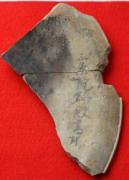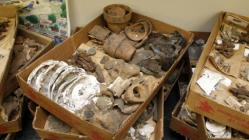10 - 11 DECEMBRE
INDI-UNI : ANTHROPOLOGY - ARCHAEOLOGY
INSCRIPTION 2012 COURS A DISTANCE
REGISTRATION 2012 ONLINE COURSES
IRAN – Dastvar - An expert of the Shushtar Cultural Heritage, Tourism and Handicrafts Office has said that the ruins of the ancient city of Dastvar in Khuzestan Province have been repeatedly looted by groups of invaders over the past few months. Dastvar was part of Elymais, an ancient Parthian vassal state located east of the lower Tigris River and usually considered part of the larger district of Susiana. It incorporated much of the area of the biblical region of Elam, approximately equivalent to the modern region of Khuzestan. The Parthian king Mithradates I (reigned 171–138 BC) captured the province of Elymais and then invaded Babylonia. The site was excavated for the first time in 1968 by a team of Iranian archaeologists led by Ali-Akbar Sarafraz. Ruins of a grave built of bricks, several kilns used for baking pottery and a number of earthenware containers were discovered during the excavation. The site was excavated four more times by other archaeological teams in 1984, 1988, 1993 and 1998. Blue glazed pottery coffins bearing patterns of braziers and palms were discovered in one of the excavations. They also found pottery coffins decorated with patterns of bunches of grapes and leaves from a grape vine. Busts of Anahiti, an ancient Iranian goddess of royalty, war and fertility, and Mithras, the god of light and truth, were unearthed during the studies.
http://www.tehrantimes.com/arts-and-culture/93349-ruins-of-ancient-city-plundered-in-southwestern-iran
JAPON –  Kyoto - The Kyoto City Archaeological Research Institute said it has unearthed earthenware in an excavation site, which is believed to be the remains of a residence for Fujiwara no Yoshimi, a prominent politician and court noble in the Heian period (794 to 1185). The earthenware found is inscribed with black ink as "Sanjo-in Tsuridono Takatsuki" (Sanjo residence, palatial-style 'tsuridono' architecture, pedestal serving bowl). The Chinese character "in" in the inscription means a "great residence." The research institute said the Chinese characters such as "in" inscribed on the pottery support the theory that the remains where it was unearthed were those for the residence of Fujiwara no Yoshimi. It was the first time that the location of a residence of an aristocrat within Heiankyo (present-day Kyoto) had been confirmed. The earthenware was discovered when research was conducted on the building of a new campus for Bukkyo University there. Old documents and other materials had suggested that the residence of Fujiwara no Yoshimi could be in that area, but there were also different views. Fujiwara no Yoshimi was a younger brother of Fujiwara no Yoshifusa, who became the first regent from outside the Imperial Family. Old documents show that Empress Dowager Nobuko, Yoshimi's elder sister, had stayed at the residence for about one year from 859. The Chinese character "in" refers to a structure where the Imperial Family stayed, and the pedestal serving bowl, which was inscribed in Chinese characters, is believed to have been used in a traditional palatial-style "tsuridono" architecture overhanging the pond. The remains of the pond and the "tsuridono" architecture were also found along with ceramics imported from China. Nishisanjodai, the name of Fujiwara no Yoshimi's residence, was also called "Hyakkatei" (One hundred flower pavilion) where Emperor Seiwa is believed to have hosted a cherry flower banquet. Yoshihiro Marukawa, a senior official of the research institute said, "It becomes clear that (Fujiwara no Yoshimi) had major power. Based on the analysis of the artifacts, it is believed to have been built in the latter half of the 9th century, which coincided with the declining period of the Yoshimi family."
Kyoto - The Kyoto City Archaeological Research Institute said it has unearthed earthenware in an excavation site, which is believed to be the remains of a residence for Fujiwara no Yoshimi, a prominent politician and court noble in the Heian period (794 to 1185). The earthenware found is inscribed with black ink as "Sanjo-in Tsuridono Takatsuki" (Sanjo residence, palatial-style 'tsuridono' architecture, pedestal serving bowl). The Chinese character "in" in the inscription means a "great residence." The research institute said the Chinese characters such as "in" inscribed on the pottery support the theory that the remains where it was unearthed were those for the residence of Fujiwara no Yoshimi. It was the first time that the location of a residence of an aristocrat within Heiankyo (present-day Kyoto) had been confirmed. The earthenware was discovered when research was conducted on the building of a new campus for Bukkyo University there. Old documents and other materials had suggested that the residence of Fujiwara no Yoshimi could be in that area, but there were also different views. Fujiwara no Yoshimi was a younger brother of Fujiwara no Yoshifusa, who became the first regent from outside the Imperial Family. Old documents show that Empress Dowager Nobuko, Yoshimi's elder sister, had stayed at the residence for about one year from 859. The Chinese character "in" refers to a structure where the Imperial Family stayed, and the pedestal serving bowl, which was inscribed in Chinese characters, is believed to have been used in a traditional palatial-style "tsuridono" architecture overhanging the pond. The remains of the pond and the "tsuridono" architecture were also found along with ceramics imported from China. Nishisanjodai, the name of Fujiwara no Yoshimi's residence, was also called "Hyakkatei" (One hundred flower pavilion) where Emperor Seiwa is believed to have hosted a cherry flower banquet. Yoshihiro Marukawa, a senior official of the research institute said, "It becomes clear that (Fujiwara no Yoshimi) had major power. Based on the analysis of the artifacts, it is believed to have been built in the latter half of the 9th century, which coincided with the declining period of the Yoshimi family."
http://mdn.mainichi.jp/mdnnews/news/20111209p2a00m0na039000c.html
ROYAUME UNI – Cannock - Historians believe they have unearthed evidence of a 4,000-year-old Stone Age camp in the Midlands. Roger Hall discovered a handful of strange-shaped rocks while walking his pet pooch in picturesque Cannock Wood, Staffordshire, But experts have identified them as flint ‘flakes’ – the off-cuts from tools crafted by Stone Age Man an astonishing 4,000 years ago. If confirmed, they could mark the spot of the only neolithic camp known in our region, says Roger Knowles, a member of the Council for British Archaeology.
http://www.sundaymercury.net/news/midlands-news/2011/12/11/evidence-of-stone-age-camp-discovered-in-cannock-66331-29932745/
INDE – Kottapuram - Kottapuram Fort or Cragnore Fort is one of the main excavation sites for the department of Archaeology. The relics found over here indicate Kodungallur's involvement in the trade relation much before the contended 2nd century BC. Evidences reveal that it was an important trade port in the ancient spice route, which extends upto various South-East and Western countries.
http://timesofindia.indiatimes.com/city/kochi/International-seminar-on-Muziris-maritime-history/articleshow/11064772.cms
FALKLANDS - A TV archaeologist has revealed controversial plans to excavate the battlefields of the Falklands War even though the conflict only took place 30 years ago. Veteran groups have warned that such an exploration would be inappropriate after such a short time, with many combatants and friends and relatives of the dead still alive. Glasgow University academic Dr Tony Pollard is preparing the major project to unearth secrets of the 1982 campaign by British forces to seize back the South Atlantic island chain from Argentinian invaders.
http://www.scotsman.com/scotland-on-sunday/review/tv-reviews/tv_project_to_dig_up_falklands_battle_sites_1_2002418
USA –  Cedar Rapids - It’s hard to tell which discovery that archaeologist David Benn is most excited about: The treasure trove of more-than-century-old bottles, trinkets, pieces of china, coins, nails, animal bones and much more that he and his digging crew unearthed here this fall in an effort to unravel the story of late 19th century working-class Cedar Rapids? Or the portion of a single spear point shaped from chert that the crew found 8 feet below a city parking lot along the Cedar River and that Benn said comes from prehistoric Cedar Rapids of some 9,500 years ago? He calls the find of the Hardaway spear point — named for a discovery site in North Carolina — “significant” and a rare event in Iowa and the Midwest. The rare find of the Hardaway spear point came from undisturbed soil about 8 feet below the city parking lot. The estimated age, about 9,500 years old, comes from its similarity to spear points dated from more extensively studied sites, he said. “This looks like a temporary camp where a couple of guys on a hunting trail stopped and camped,” said Benn, who holds a doctoral degree in anthropology and archaeology from the University of Wisconsin at Madison. “It looks like one of the guys was refurbishing his weapon. The spear point broke. He took it off and put a new one on.” Benn said 9,500 years ago, people had been in Iowa for a couple thousand years, and he described the Hardaway spear point found from that time as very thin and technologically advanced over projectile points from an earlier time. The dig also turned up prehistoric pieces of pottery from the Late Woodland Period of 1,000 to 1,500 years ago and the Middle Woodland period of about 2,000 years ago. Much of the Benn team’s work focused on the historic, not prehistoric, in the hunt for artifacts of the earliest settlers in Cedar Rapids in the 1840s and of the first established residents in the city’s early working-class neighborhoods of 1870 to the 1890s in around the former Sinclair plant.
Cedar Rapids - It’s hard to tell which discovery that archaeologist David Benn is most excited about: The treasure trove of more-than-century-old bottles, trinkets, pieces of china, coins, nails, animal bones and much more that he and his digging crew unearthed here this fall in an effort to unravel the story of late 19th century working-class Cedar Rapids? Or the portion of a single spear point shaped from chert that the crew found 8 feet below a city parking lot along the Cedar River and that Benn said comes from prehistoric Cedar Rapids of some 9,500 years ago? He calls the find of the Hardaway spear point — named for a discovery site in North Carolina — “significant” and a rare event in Iowa and the Midwest. The rare find of the Hardaway spear point came from undisturbed soil about 8 feet below the city parking lot. The estimated age, about 9,500 years old, comes from its similarity to spear points dated from more extensively studied sites, he said. “This looks like a temporary camp where a couple of guys on a hunting trail stopped and camped,” said Benn, who holds a doctoral degree in anthropology and archaeology from the University of Wisconsin at Madison. “It looks like one of the guys was refurbishing his weapon. The spear point broke. He took it off and put a new one on.” Benn said 9,500 years ago, people had been in Iowa for a couple thousand years, and he described the Hardaway spear point found from that time as very thin and technologically advanced over projectile points from an earlier time. The dig also turned up prehistoric pieces of pottery from the Late Woodland Period of 1,000 to 1,500 years ago and the Middle Woodland period of about 2,000 years ago. Much of the Benn team’s work focused on the historic, not prehistoric, in the hunt for artifacts of the earliest settlers in Cedar Rapids in the 1840s and of the first established residents in the city’s early working-class neighborhoods of 1870 to the 1890s in around the former Sinclair plant.
http://thegazette.com/2011/12/10/archaeologists-dig-up-details-of-cedar-rapisds-distant-past/